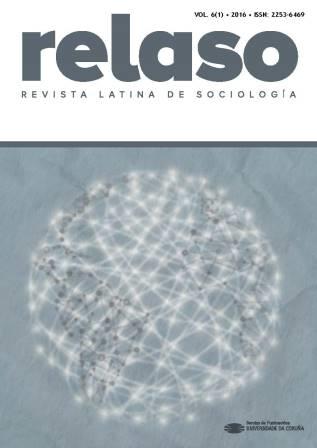Analisis multinivel con variables categóricas. Ejemplo: confianza en la plutocracia
Contenido principal del artículo
Resumen
El objetivo de este artículo es analizar la importancia del ámbito contextual además del individual en las investigaciones sociales, políticas o de otro tipo y el funcionamiento de la técnica multinivel para su aplicación. Explicamos la importancia de las técnicas multinivel y los distintos modelos que debemos de tener en cuenta para realizar los análisis y así poder explicar los efectos de las variables individuales, contextuales y finalmente los efectos aleatorios del nivel agregado (en este caso los países). Todo ello lo desarrollamos para cuando la variable dependiente es dicotómica. Ejemplificamos con el análisis de a un caso concreto, la confianza de los ciudadanos en exclusiva en el Banco Central Europeo.
Palabras clave:
Descargas
Métricas
Detalles del artículo
Citas
Ariño, A. (2016). ¿Hacia una plutocracia global?. Revista Española de Investigaciones Sociológicas, 25(1), 37-59.
Banco Central Europeo –BCE- (2013). “Independencia”. Recuperado de http://www.ecb.int/ecb/orga/independence/html/index.es.html
Beck, U. (1988). ¿Qué es la globalización?. Falacias del globalismo, respuestas a la globalización. Barcelona: Paidós.
Bell, D. (1992). El fin de las ideologías. Sobre el agotamiento de las ideas políticas en los años cincuenta. Madrid: Centro de Publicaciones Ministerio de Trabajo y Seguridad Social.
Berman, S. & Mcnamara, K. R. (1999). Bank on Democracy. Why Central Banks Need Public Oversight?. Foreign Affairs, 78(2), 2-8.
Cebolla Boado, H. (2013). Introducción al análisis multinivel. Madrid: Centro de Investigaciones Sociológicas.
Curtis, B. (1978). William Graham Sumner and the Problem of Progress. New England Quarterly, 51(3), 348-369.
Díez Medrano, J. (2003). Framing Europe. Attitudes to European Integration in Germany, Spain and the United Kingdom. New Jersey: Princeton University Press.
Escobar, M., Fernandez, E. y Bernardi, F. (2009). Análisis de datos con Stata. Madrid: Centro de Investigaciones Sociológicas.
Financial Crisis Inquiry Commission (2011). Final Report of the National Commission on the Causes of the Financial and Economic Crisis in the United States, Washington, DC. U.S. Government Printing Office. Available at http://www.gpo.gov/fdsys/pkg/GPO-FCIC/pdf/GPO-FCIC.pdf
Fukuyama, F. (1992). El fin de la historia y el último hombre. Barcelona: Planeta.
Gabel, M. & Palmer, M. (1995). Understanding Variation in Public Support for European Integration. European Journal of Political Research, 39, 459-489
Goldstein, H., Browne, W. & Rasbash, J. (2002). Partitioning variation in generalized linear multilevel models. Understanding Statistics, 1, 223–32.
Green, R. T. (2012). Plutocracy, Bureaucracy, and the End of Public Trust. Administration & Society, 44(1), 109-143.
Grün, R. (2007). Entre a plutocracia e a legitimaçâo financeira, Revista Brasileira de Ciências Sociais, 22 (65), 85-107.
Habermas, J. (1984). Ciencia y técnica como ideología. Madrid: Tecnos.
Hamilton, L-C. (2013). Statistics with STATA. Version 12. Belmont. Brooks/Cole Cengage Learning.
Heck, R. K. & Scott, L. T. (2000). An introduction to multilevel modeling techniques. Mahwah: Lawrence Erlbaum Associates.
Inglehart, R. (1970). Cognitive Mobilization and European Identity. Comparative Politics, 3(1), 45-70.
Kaltenthaler, K., Anderson, C. & Miller, W. (2010). Accountability and Independent Central Banks: Europeans and Distrust of the European Central Bank. Journal of Common Market Studies, 48(5), 1261–1281.
Kim, J.-S. (2009). Multilevel analysis: An overview and some contemporary issues. En R. E. Millap, R. E.& A. Maydeu-Olivares, A. (Eds.) The SAGE handbook of quantitative methods in Psychology. London: Sage Publications.
Kreft, I. and De Leeuw J. (1998). Introducing multilevel modeling. London: Sage
Merlo, J., Chaix, B., Ohlsson, H., Beckman, A., Johnell, K., Hjerpe, P., Rastam, L. & Larsen, K. (2006). A brief conceptual tutorial of multilevel analysis in social epidemiology: using measures of clustering in multilevel logistic regression to investigate contextual phenomena. J Epidemiology Community Health, 60, 290-297
Montero, J., Zmerli, S. & Newton, K. (2008). Social trust, political confidence, and satisfaction with democracy. Revista Española de Investigaciones Sociológicas (REIS), 122, 11-54.
Pardo, A.; Ruiz, M. A. y San Martín, R. (2007): Cómo ajustar e interpretar modelos multinivel con SPSS. Psicothema, 19, nº 2, 308-321.
Rabe-Hesketh, S. and Skrondal, A. (2012). Multilevel and Longitudinal Modeling Using Stata. Vol. I: Continuous Responses, Vol. II: Categorical Responses, Counts, and Survival. Texas: A Stata Press Publication.
Rasbash, J., Browne, W., Goldstein, H., Yang, M., Plewis, I., Healy, M., Woodhouse, G., Draper, D., Langford, I., & Lewis, T. (2000). A user’s guide to MlwiN (versión 2.1). London: University of London, Institute of Education.
Rasbash, J., Steele, F., Browne, W. & Goldstein, H. (2009). A User’s Guide to MlwiN Version 2.10. Available at http://www.bristol.ac.uk/cmm/software/mlwin/download/mlwin-userman-09.pdf.
Raudenbush, S.W., Bryk, A.S., Cheong, Y.F., & Congdon, R. (2000). HLM 5: Hierarchical linear and nonlinear modeling. Lincolnwood, IL: Scientific Software International.
Roth, F.; Gros, D. & Nowak-Lehmann, F. (2012). Has the Financial Crisis eroded Citizens’ Trust int the European Central Bank?. Panel data Evidence for the Euro Area, 1999-2011. Centre for European, Governance and Economic Development Research. Discussion Papers. Available at http://papers.ssrn.com/sol3/papers.cfm?abstract_id=1847465
Sabeel Rahman, K. (2011). Conceptualizing the economic role of the state: Laissez-faire, technocracy, and the democratic alternative. Polity, 43(2), 264-286.
Sanz, N. (2008). La apropiación política de la ciencia: origen y evolución de una nueva tecnocracia. Revista CTS, 4(10), 85-123
Shaw, J. B. (1989). The Apple Cart: A Political Extravaganza. London: Penguin Books. Original de 1930
Snijders, T. & Bosker, R. (2012). Multilevel Analysis. An Introduction to Basic and Advanced Multilevel Modeling. London: Sage.
Stiglitz, J. (1998). Central banking in a democratic society. De Economist, 146(2), 199-200.
Sumner, W. G. (1902). The Concentration of Wealth: Its Economic Justification. Independent, April-June. Aavailable at http://oll.libertyfund.org/?option=com_staticxt&staticfile=show.php%3Ftitle=1656&chapter=143464&layout=html&Itemid=27
Trask, H. A. (2004). Willian Graham Sumner: Against Democracy, Plutocracy and Imperialism. Journal of Libertarian Studies, 18(4), 1-27.
U.S. Senate Permanent Subcommittee on Investigations, Committee on Homeland Security and Governmental Affairs, Carl Levin, Chairman, Tom Coburn, Ranking Minority Member (2011). Wall Street and the Financial Crisis: Anatomy of a Financial Collapse. Available at http://www.hsgac.senate.gov
WEBER, M. (1993). La ética protestante y el espíritu del capitalismo. Barcelona: Península.


